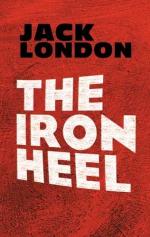I lived through three days of the Chicago Commune, and the vastness of it and of the slaughter may be imagined when I say that in all that time I saw practically nothing outside the killing of the people of the abyss and the mid-air fighting between sky-scrapers. I really saw nothing of the heroic work done by the comrades. I could hear the explosions of their mines and bombs, and see the smoke of their conflagrations, and that was all. The mid-air part of one great deed I saw, however, and that was the balloon attacks made by our comrades on the fortresses. That was on the second day. The three disloyal regiments had been destroyed in the fortresses to the last man. The fortresses were crowded with Mercenaries, the wind blew in the right direction, and up went our balloons from one of the office buildings in the city.
Now Biedenbach, after he left Glen Ellen, had invented a most powerful explosive—“expedite” he called it. This was the weapon the balloons used. They were only hot-air balloons, clumsily and hastily made, but they did the work. I saw it all from the top of an office building. The first balloon missed the fortresses completely and disappeared into the country; but we learned about it afterward. Burton and O’Sullivan were in it. As they were descending they swept across a railroad directly over a troop-train that was heading at full speed for Chicago. They dropped their whole supply of expedite upon the locomotive. The resulting wreck tied the line up for days. And the best of it was that, released from the weight of expedite, the balloon shot up into the air and did not come down for half a dozen miles, both heroes escaping unharmed.
The second balloon was a failure. Its flight was lame. It floated too low and was shot full of holes before it could reach the fortresses. Herford and Guinness were in it, and they were blown to pieces along with the field into which they fell. Biedenbach was in despair—we heard all about it afterward—and he went up alone in the third balloon. He, too, made a low flight, but he was in luck, for they failed seriously to puncture his balloon. I can see it now as I did then, from the lofty top of the building—that inflated bag drifting along the air, and that tiny speck of a man clinging on beneath. I could not see the fortress, but those on the roof with me said he was directly over it. I did not see the expedite fall when he cut it loose. But I did see the balloon suddenly leap up into the sky. An appreciable time after that the great column of the explosion towered in the air, and after that, in turn, I heard the roar of it. Biedenbach the gentle had destroyed a fortress. Two other balloons followed at the same time. One was blown to pieces in the air, the expedite exploding, and the shock of it disrupted the second balloon, which fell prettily into the remaining fortress. It couldn’t have been better planned, though the two comrades in it sacrificed their lives.




